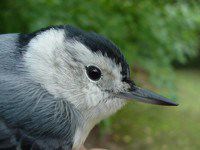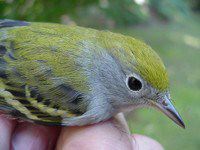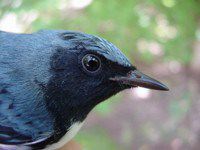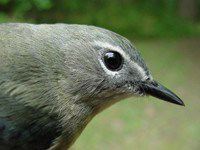|
All text & photos © Hilton Pond Center
Without a doubt, 24 September 2000 was an amazing day for nature happenings at Hilton Pond Center. On that one day:
- We banded our 38,000th bird since June 1982, when the Center's long-term study of Piedmont avifauna began. That's an average of 2,000 birds banded annually for the past 19 years! Just four species (Purple Finch, House Finch, American Goldfinch, and Pine Siskin) have accounted for 44% of the total, but in late September and early October migrant warblers and thrushes usually hit the mist nets in good numbers (see list below).
 The 38,000th bird banded was a young male Wilson's Warbler (right), only the second one ever seen locally; the other was captured during fall migration in 1995. This species-- which breeds in southern Canada, Alaska, and the far western United States--is a rare migrant in South Carolina. The 38,000th bird banded was a young male Wilson's Warbler (right), only the second one ever seen locally; the other was captured during fall migration in 1995. This species-- which breeds in southern Canada, Alaska, and the far western United States--is a rare migrant in South Carolina.
- We banded our 2,300th Ruby- throated Hummingbird since 1984. It was the 180th local hummer for 2000, making this year the third best for hummingbird banding. (Because it is already late September, it seems unlikely we'll reach our record of 197 hummingbirds banded in 1991.)
- A Long-tailed Skipper (Urbanus proteus), a butterfly new to the Center, was observed feeding on nectar from Pickerelweed flowers in the small water garden. (Our survey of on-site butterflies is just getting started, but this was the tenth species positively identified.)
- A flock of perhaps 500 Common Grackles descended on the property, feeding on acorns and Black Gum berries and littering the ground beneath the trees with seeds, shells, and droppings. (The noise they made give an idea of why they're called "grackles." All six that were netted were young of the year.
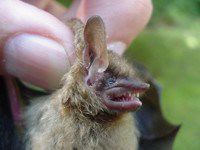 Just a week after capturing a Red Bat in one of our mist nets, we snared an Eastern Pipistrelle (Pipistrellus subflavus)--in the same net and in broad daylight! This is our second bat species positively identified at Hilton Pond Center, and our 24th mammal (photo at right). Just a week after capturing a Red Bat in one of our mist nets, we snared an Eastern Pipistrelle (Pipistrellus subflavus)--in the same net and in broad daylight! This is our second bat species positively identified at Hilton Pond Center, and our 24th mammal (photo at right).
- Three species of large wading birds-- Great Egret, Great Blue Heron, and Little Blue Heron--showed up in the shallows around the pond. The Little Blue was an obvious immature, since its plumage was still pure white.
- While checking mist nets for birds, we came face-to-face with two half-grown River Otters that popped their heads above the pond surface. This is the second year in a row we've seen this species at the Center--a good sign for an aquatic animal that was nearly extirpated from the Carolinas due to over-trapping, persecution, and habitat loss.
- Another aquatic species revealed itself during a later net check: Southern Leopard Frog (Rana sphenocephala). Through the years, we've occasionally heard the "clucking" call of this species at night, but daytime observations have always been of its close relative, the Pickerel Frog (R. palustris). This new sighting brought the Center's frog list to seven species.
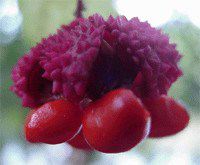 Strawberry-bush (top of page & right) was in full fruit all around the Center. This green-stemmed native shrub, Euonymus americanus, is also called "Hearts-a-Bursting" because of the way its strawberry-red seed pod opens to reveal four shiny crimson berries. Strawberry-bush (top of page & right) was in full fruit all around the Center. This green-stemmed native shrub, Euonymus americanus, is also called "Hearts-a-Bursting" because of the way its strawberry-red seed pod opens to reveal four shiny crimson berries.
- Two bird banding milestones, three new animal species, several good looks at common or unusual flora and fauna--in other words, there was almost TOO much to take in all at once on 24 September at Hilton Pond Center. Sometimes it just pays to go outside!
|
